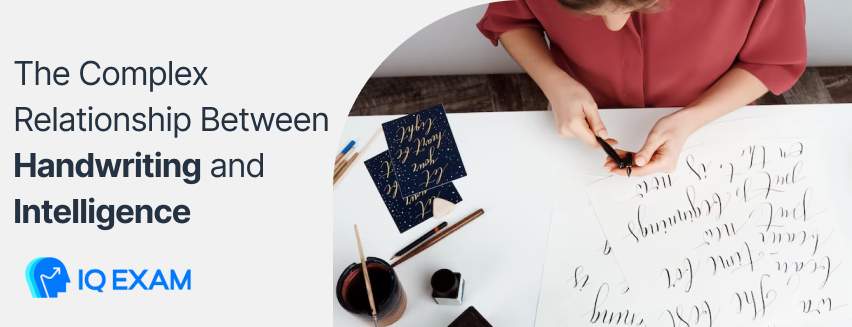
Are you one of those people whose handwriting looks like a secret code even Sherlock Holmes couldn’t crack? We’re about to delve into the fascinating world of handwriting and its mysterious ties to intelligence.
Handwriting and intelligence are separate attributes that do not necessarily correlate. Intelligence is a complex trait influenced by various factors, while motor skills, personal style, and other factors unrelated to intelligence can influence handwriting.
We will discuss the myths, explore the factors that affect handwriting, and reveal the surprising reality behind its link to intelligence.
Messy and Bad Handwriting: Misconceptions and Explanations
People usually relate bad handwriting to low intelligence by mistake; therefore, it is essential to question this belief and replace it with reasonable and scientific explanations. Handwriting is a skill that can be affected by different factors, such as muscle control, motor skills, writing speed, and handwriting style.
Bad Handwriting is not an indicator of low intelligence.
As we stated before, people usually believe that a person with bad handwriting is a person with a low IQ level, but this belief is not comprehensive enough as it won’t consider different factors which can affect an individual’s handwriting style. Intelligence involves a broad range of cognitive skills far from clear or neat handwriting.
What are the alternative assumptions for bad Handwriting
Providing only one explanation for bad handwriting is impossible as many factors can participate in this assumption. For example, motor skills, writing speed, muscle coordination, and writing style can all play a role in molding an individual’s handwriting. As a result, a person’s handwriting depends on their multiple cognitive skills.
By paying attention to these alternative explanations, we can change our point of view and understand that bad handwriting is not the only indicator of intelligence level. We should gain a clear understanding of these factors instead of relating bad handwriting to intelligence with no scientific explanation and put an end to this sloppy assumption.
Factors Influencing Bad Handwriting

Should bad handwriting be considered an indicator?
We should consider scientific explanations when discussing bad handwriting to understand its fundamental causes. Bad handwriting can be related to different reasons, such as motor skills issues, spatial awareness difficulties, or visual problems that a person might have.
These scientific explanations can offer us valuable insights about handwriting complications and help us not to become judgmental based on appearances.
Examining the subjective nature of bad handwriting
Our understanding of a person’s good or bad handwriting can be subjective because one person might think handwriting is bad or ugly, and someone else thinks it is beautiful and even unique. Therefore, when we talk about bad handwriting, it depends on our taste.
Even people with artistic handwriting have different handwriting styles due to their personal styles, taste, and cultural influences. Understanding the subjective nature of handwriting enables us to respect the diversity and personal interests that handwriting can offer, which is far more than solid “good” or “bad” standards.
Exploring reasons behind bad handwriting
To understand the reasons behind bad handwriting, we should explore the factors that lead to its emergence. One of the most important reasons is the handwriting and motor skills relationship.
Handwriting requires the coordination and control of motor skills, including hand and finger integration, grip power, and artistry. If a person is incapable in one of these areas, they might have bad or messy handwriting. By exploring the connection between handwriting and motor skills, we will gain valuable insights into the challenges that people might face, and we will be able to find new strategies to make improvements in this field.
By studying the scientific explanations, understanding handwriting’s subjective nature, and realizing the impact of motor skills, we can better understand motor skills’ role and other factors influencing bad handwriting.
This comprehensive point of view lets us support individuals to improve their handwriting skills and encourages them to insert a broader approach regarding handwriting abilities.
The Complex Relationship Between Handwriting and Intelligence

We must explore the complicated relationship between handwriting and intelligence to avoid misunderstanding. Opposed to the usual belief, there is no direct relation between bad handwriting and intelligence level, as intelligence includes a broad range of cognitive skills.
Understanding the limitations of the usual assumption that believes bad handwriting indicates low intelligence is crucial. We must understand that different reasons can influence handwriting, and we shouldn’t consider it the only indicator for measuring intellectual ability.
The myth of a direct correlation between messy handwriting and intelligence
It is time to question the old myth about considering bad handwriting as an indicator of low intelligence. In contrast to the usual belief, there is no direct relation between bad handwriting and intelligence level.
Handwriting is a skill that includes different aspects, such as muscle control, motor skills, and personal style. On the other hand, intelligence includes a comprehensive range of cognitive abilities, problem-solving skills, and knowledge levels. Let’s speak the truth and surpass this misinformed assumption.
Analyzing the limitations and pitfalls of using handwriting as an intelligence indicator
As handwriting has been associated with intelligence level since a long time ago, it is crucial to evaluate the limitations of this point of view. Applying handwriting as the only indicator of intelligence level will leave the complexity of human cognition unnoticed.
Handwriting can be influenced by diverse factors such as cultural influence, physical conditions, and personal taste. Using handwriting as a trusted indicator for evaluating someone’s intelligence level can lead to false conclusions and ignore the other vital aspects of an individual’s intellectual capacity.
Applying a more comprehensive approach to assess intelligence level is crucial instead of just counting on handwriting as an evaluating indicator.
Handwriting and Thinking Styles

The way we put pen to paper can offer clues about our cognitive processes, creativity, and organization. Analyzing handwriting allows us to uncover the unique traits of different thinking styles, whether the precision of analytical minds or the artistic flair of creative thinkers.
The connection between cognitive processes and handwriting
There is a fascinating connection between handwriting and cognitive processes that deserves exploration. Handwriting can provide insights into how individuals think, organize information, and express themselves.
By studying the relationship between handwriting and cognitive processes, We can better understand the complex link between the mind and the page.
Thinking styles and their influence on handwriting
One interesting aspect to consider is how different thinking styles can influence handwriting. Analytical thinkers may exhibit precise and structured handwriting, while creative thinkers may showcase more fluid and expressive strokes.
By studying thinking styles and their impact on handwriting, we can uncover valuable clues about an individual’s cognitive preferences and patterns.
Investigating alternative approaches to identifying intelligence through handwriting
While handwriting has been used as a potential tool for assessing intelligence, it is important to explore alternative approaches. One such method is graphology, which attempts to interpret personality traits and intelligence based on handwriting analysis.
However, it is essential to critically examine the scientific validity and limitations of graphology as a reliable method for intelligence identification.
Examining graphology and its limitations as a scientific method
When exploring the world of graphology, we must recognize its limitations as a scientific method. While it may provide interesting insights, the subjective nature and lack of empirical evidence limit its reliability and credibility. It is crucial to approach graphology cautiously, understanding that its interpretations should not be taken as definitive intelligence indicators.
We can understand the relationship between handwriting and intelligence by exploring the connection between cognitive processes and handwriting, considering different thinking styles, and examining alternative approaches like graphology.
However, it is important to approach these methods with a critical mindset, understanding their limitations and seeking a holistic approach to assessing intelligence.
FAQ

Is it true that intelligent people have messy handwriting?
Handwriting is a complex skill, and various factors impact it. Moreover, no solid proof supports the claim that smart people tend to have messy handwriting.
Does handwriting affect intelligence?
Handwriting can potentially impact fine motor skills and coordination. Based on research, there is no direct relationship between handwriting and intelligence. Intelligence is beyond the scope of handwriting, and it is not that simple. Intelligence refers to diverse cognitive functions, problem-solving skills, and knowledge.
Do people with bad handwriting think faster?
There is no inherent correlation between fast thinking and bad handwriting. Fast thinking relates to cognitive processing speed; however, bad handwriting can be influenced by motor skills, writing speed, and personal writing style. These factors can vary independently for an individual and do not necessarily indicate a correlation between these two.
Final words
We have explored the complex relationship between handwriting and intelligence, recognizing that clean handwriting alone does not determine one’s intellect. We have embraced a more comprehensive and inclusive perspective by understanding the various factors that influence handwriting and the limitations of using it as a sole intelligence indicator.
So, dear reader, as you set down your pen or pencil, remember that intelligence encompasses many abilities, and your handwriting uniquely expresses your individuality.
Welcome the beauty in your strokes, and let your thoughts flow freely. Happy writing, and may your words shape a world of boundless possibilities!
